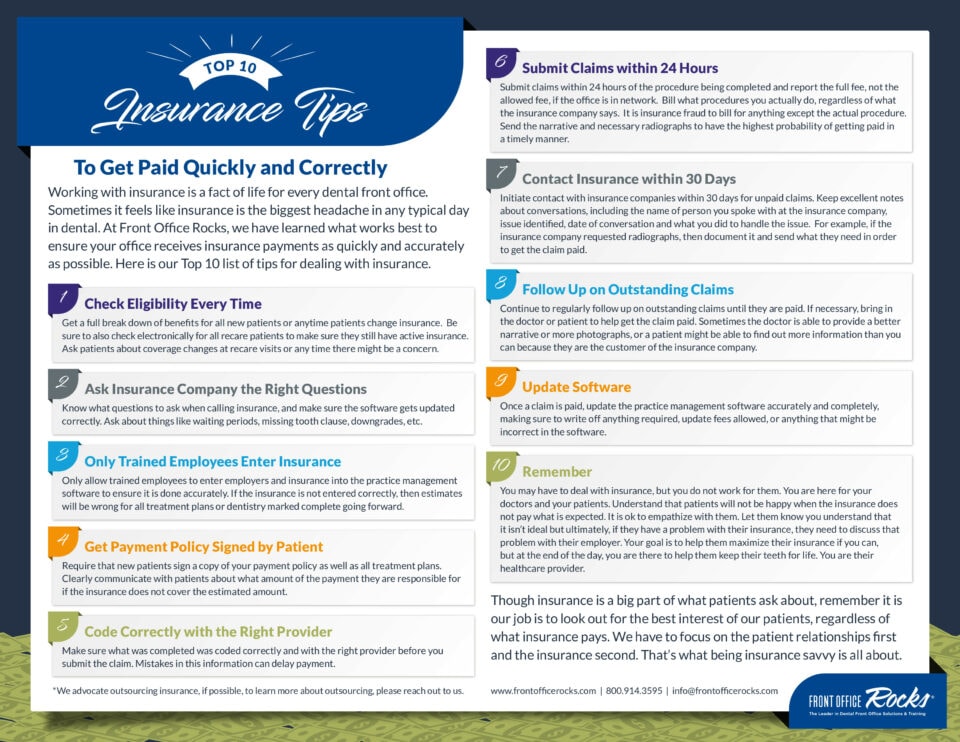Dealing with dual dental insurances takes time, patience, and a little bit of math
Article by Colleen Huff, FAADOM
Dental office managers have big jobs dealing with insurance companies. The job is doubled when patients carry two insurances. Many of us in the dental insurance industry have heard the following statements from patients: “I have two insurances, so why should I have to pay anything?” “Can’t you just write that off?” or “Why am I getting a bill six months after the work was done? Both of my insurances should have paid that!”
These and many more frustrations can occur when dealing with dual dental insurances, and some of the most difficult times for insurance coordinators is when they must deal with two insurance companies. Here I will tackle a few of the most common questions I hear when I speak to groups across the country.
Where to begin
To start, dental office managers need to ascertain whether a patient’s secondary insurance is a regular coordination of benefits (COB) or a non-duplication plan. Regular COB means that, in theory, the secondary should pick up the balance that the primary does not pay. Keep in mind that there are still deductibles and maximums to keep track of. Non-duplication plans do exactly what they state—they do not duplicate what the primary has paid.
Here’s an example. Joe has a crown done that costs $800. Primary insurance pays $400. The secondary would pay $500 if it was the only insurance. Therefore, it will not duplicate what the primary has paid and will pay only an additional $100, which leaves the patient with a balance of $300. The easiest way to determine this kind of coordination is to look at each plan as if it was the only plan. This will allow you to determine the highest amount that will be paid.
One of the questions I hear most is, “Do I have to bill the secondary insurance? Can’t I just let the patient worry about that?”
If you participate with the insurances, then yes, you need to bill the secondary. The reason for this is that you need to make sure that you are making the correct adjustments based on contracted fees. You are obligated to honor your contracts, and this includes not charging a patient above the lowest contracted fee. You can collect up to your full fee from the two insurance companies if possible, yet you must make sure that you do not charge the patient anything above the lowest contracted rate. Here are examples.
Mary has two insurances. Your office’s regular fee is $100 for a procedure. The primary contracted rate is $70, and the secondary is $80. Between the two you may collect either that $80, or the secondary may pay up the full $100 fee. The issue is that you must make sure you are not charging a copay to the patient above the $70 fee you have agreed to.

For example, if the secondary pays nothing the patient is only responsible for up to the $70 total fee. So, if primary paid $50 and secondary paid nothing, the patient’s copay would be $20. Another reason I feel that practices should handle the secondary payment is due to the customer service aspect. I believe it is a best practice to handle all insurance claims whenever possible for patients. This can set your practice apart from other offices in your area. Your patients will appreciate it, and this may lead to increased referrals.
Downgrading and bundling
Another question I hear often involves insurance companies downgrading procedures. People ask, “Can I charge the difference to the patient?” The short answer is yes, you can bill up to the approved contracted amount for the procedure that was performed.
Here’s an example. Mike had a posterior composite filling done. The PPO fee is $200 that you estimate will be paid at 80%. The PPO downgrades the filling to an amalgam and will pay a fee of $150, paid at 80%, which is $120. The patient’s copayment is the difference between the $120 paid and your practice’s contracted fee of $200, which makes the patient’s out of pocket $80.
Where you must be careful with this is when the insurance company bundles work. This means they take a panorex and bitewings and bundle them into a full mouth series fee. This is contract-dependent, but in most cases you do have to accept the bundled fee. There can be exceptions to this rule, and that is why I urge you to be sure to read your contracts.
Asking for help on social media
This leads me to a bit of a different discussion about asking for guidance on social media. There are groups on social media where people can ask for input from our peers. When doing this, I urge everyone to be aware of who is answering your questions. States have different rules, so you need to be sure that the person providing you with advice knows your state rules before you try their suggestions. Also, your state dental board is a wealth of information that is accurate and up to date on all of the rules for your area. Feel free to reach out to them with your questions.
Inform patients
Remember that dealing with two insurance companies can be confusing and difficult. Educating your patients about this from the start will help them be more understanding when things do not come out as estimated. I have been doing this for 25 years and I still tell my patients that estimating with two insurances is not an exact science. The simplest bit of wrong information shared over the phone can make the estimated out-of-pocket payment wrong. Also, remember that even predeterminations are not guaranteed. You still must do the math and read the fine print for each insurance company.
So, take a deep breath and take your time. Include your patients as part of the conversation and help them understand that ultimately, insurance is a benefit to help them pay for their dental procedures.
Here’s a final thought I’d like to share:
“Nothing is impossible. The word itself says I’m possible.”
Audrey Hepburn


